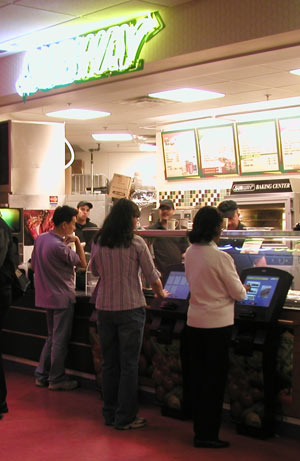Article
Have it your way: Kiosks about to make impact in QSRs
Pro-Tech's deal to become the kiosk provider for all 24,000 restaurants in the Subway chain is big news for the supplier - and perhaps even bigger news for quick-service restaurants in general. Are consumers ready for kiosk ordering at their favorite restaurant?
December 18, 2005 by James Bickers — Editor, Networld Alliance
In late November, Pro-Tech installed several touchscreen ordering kiosks at the Subway restaurant in Vanderbilt Children's Hospital in Nashville. The location was already successful by anybody's standards, processing 130 sandwiches per hour at lunchtime.
Pro-Tech president Peter Kaszycki said the store manager was skeptical that the kiosks would have much of an effect on business.
"We told him, `When we put this kiosk in, we're going to give you more orders than you can handle,'" Kaszycki said, "and he was like, `Yeah, sure.'"
Almost immediately, though, traffic for the average lunch hour jumped to 217 sandwiches. The manager had to immediately add a second food line to handle the increased volume - a problem any restaurant manager would like to have.
 This story and all the great free content on KioskMarketplace is supported by: St. Clair Interactive Communications, Inc. St. Clair's "Smart Employee" self service software delivers. Job availability, benefits enrollment and administration, training schedules and enrollment, announcements, events, etc. Request free info from this company!  |
Of course, nobody sells just one kiosk to one location of a company like Subway, which franchises 24,000 locations worldwide. In Oct. 2005, after extensive negotiation, Subway chose Pro-Tech as its global kiosk provider.
Since virtually all Subway locations are franchises (the company operates a single corporate-owned location), Pro-Tech now has the task of selling franchise organizations on the machines. He said the company currently has machines in about two dozen locations, with a goal of being in 500 to 1,000 restaurants by the end of 2006.
And he's not stopping at Subway, even though that would be enough to keep his company busy; Kaszycki said Pro-Tech is also talking to other prominent QSRs like Arby's, Jack-in-the-Box, and the Yum! Brands chains.
Spending money to save money
The QSR space is a crowded one, and operators need to watch their bottom lines more than ever. Restaurant consultant Kevin Moll said that an increasingly competitive business is driving owners and managers to turn to technology for help.
"Quality locations are few and far between," he said. "Co-branding, smaller buildings and unconventional avenues of generating revenue are taking place all around us as a result. At the end of the day, each dollar looks the same regardless of where it came from."
 Subway isn't the only QSR chain experimenting with ordering kiosks. McDonald's, Burger King and Arby's have all tested the waters. What remains to be seen, though, is just how much money the kiosks will save the companies.
Subway isn't the only QSR chain experimenting with ordering kiosks. McDonald's, Burger King and Arby's have all tested the waters. What remains to be seen, though, is just how much money the kiosks will save the companies.
The increase in traffic at the Vanderbilt Subway is not surprising, given that "sandwich artists" no longer have to spend time listening to customer preferences, trying to remember to upsell the combo meal or checking their promotional materials to see whether or not today is Free Cookie Day.
It's easy to extrapolate some profound increase in profitability from the anecdotal numbers gathered so far, but experts agree that it will all be for naught unless the kiosks are designed and implemented properly.
Getting the details right
The use of kiosks for ordering in QSRs is an emerging technology solution, and as such there aren't any established winners to mimic. Paul Barron, publisher and chief operating officer of the foodservice division of NetWorld Alliance (which also publishes KioskMarketplace), said that QSR kiosks need to be done right the first time, or else customer experiences will be seriously soured.
|
Barron said that a poorly designed ordering kiosk would be doomed because it will not likely be the only option for ordering - unlike, for instance, at the airport where kiosks have often become the only viable option for patrons unwilling to wait in long lines. "In a restaurant application, it's going to have to peg it as far as experience, as far as interface - it'll have to flow really well."
|
Kaszycki agreed that a human touch is still needed, particularly in the first few weeks of a rollout. His company recommends that the restaurant use a greeter for at least two weeks, gently introducing customers to the new tech while reminding them that help is just a few feet away.
He said that in a very short period of time, people not only become accustomed to the new system but also become ad-hoc evangelists for it.
"A funny thing happens after the first few weeks, once the greeter is pulled away," he said. "New customers that have never used the kiosk before watch other repeat customers at the kiosk, and the fear of using it goes away. In fact, experienced kiosk users are more than happy to help out other customers if they get into problems."
Kaszycki said he sees "strong but not explosive growth" in this area in 2006, with the real growth beginning in 2007. For his part, Barron points to statistics from the National Restaurant Association that foretell big spending on IT in 2006.
"With 2006, the outlook for NRA was such that labor and employee retention are still the number one issues with operators," he said. "With the continued pressure that you've got in the workforce, at least in the quick-service space and maybe even in fast casual and casual dining, any kind of self-service options are going to be very welcomed by the industry."












